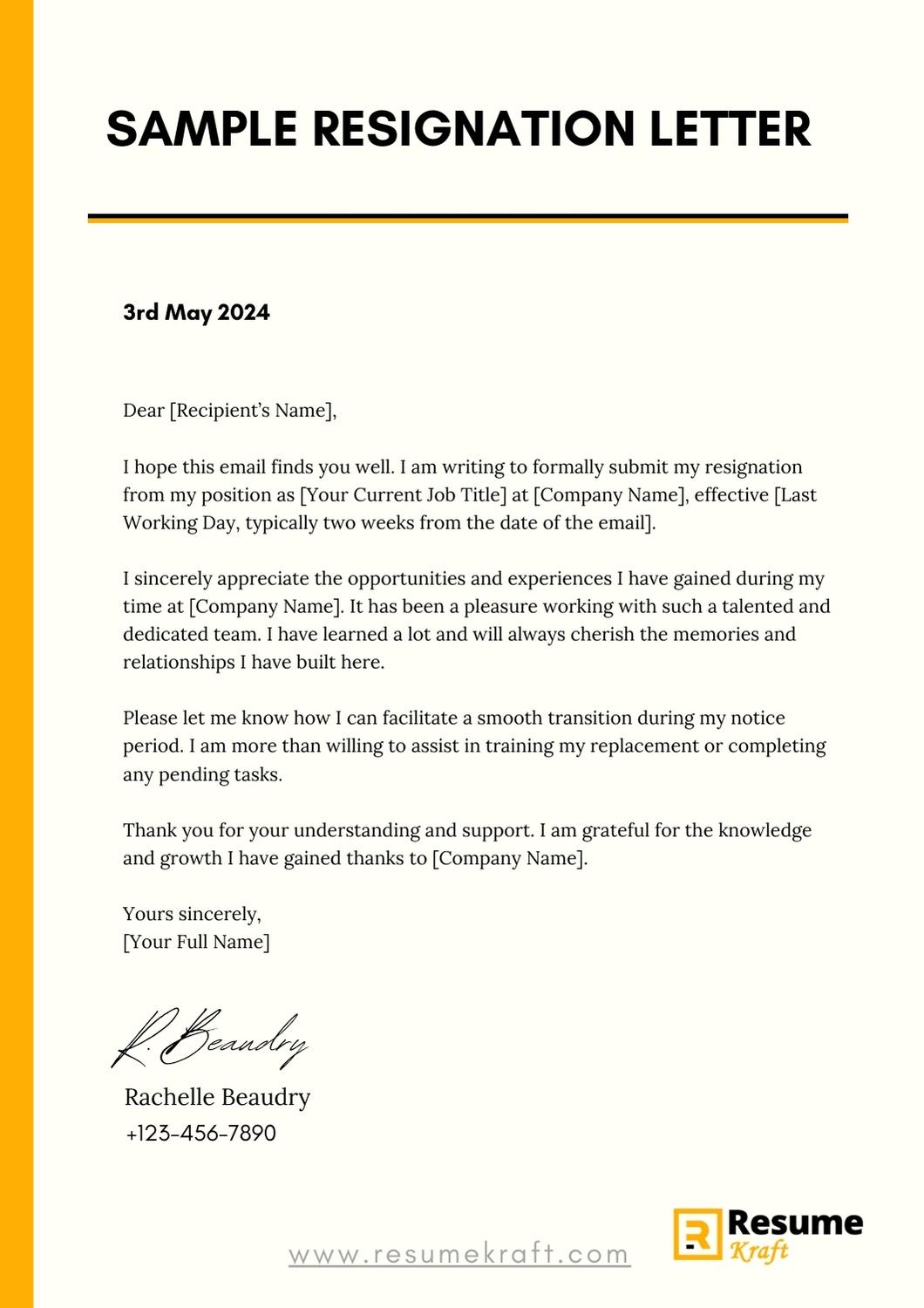
In today’s job market, professionalism and courtesy are highly valued. This extends to the way we communicate, even when leaving a position. A well-written resignation letter is an essential step in maintaining a positive relationship with your current employer and ensuring a smooth transition. In this article, we will guide you through the process of writing a resignation letter that showcases your professionalism and gratitude.
A professional resignation letter is crucial for several reasons. First and foremost, it serves as a formal notice to your employer that you will be leaving the company. This allows them to start the process of finding a suitable replacement and planning for the future. Additionally, a well-written resignation letter leaves a lasting impression and demonstrates your commitment to handling the transition responsibly.
The purpose of this article is to provide you with a comprehensive guide on how to write an effective resignation letter. Whether you’re leaving your current job due to personal reasons, pursuing a new opportunity, or retiring, we will cover all the necessary steps and provide you with templates and examples to ensure a smooth and professional departure.
Before we dive into the details of crafting a resignation letter, let’s start with a simple resignation letter template as a starting point. This template will provide you with a solid structure that you can adapt to your specific situation.
How to Write a Resignation Letter
When it comes time to move on from your current job, one essential step is to write a resignation letter. This formal document not only informs your employer of your decision but also ensures a professional and respectful departure. In this guide, we will walk you through the process of crafting an effective resignation letter, from formatting to content, while providing valuable tips and advice along the way.
Importance of Using Business Letter Formatting
Using proper business letter formatting is crucial when composing your resignation letter. By adhering to established norms, you convey professionalism and show respect for your employer’s expectations. The following elements should be present in your resignation letter:
- Date: Begin your resignation letter with the current date.
- Employer’s Name and Address: Include your supervisor’s name, their position, and the company’s address.
- Salutation: Address your employer respectfully, using their title and last name. If you have a close relationship, you may use their first name.
- Subject Line: Clearly state that the letter is a resignation. For example, “Resignation – [Your Name].”
- Body: Use organized paragraphs to express your intentions and express gratitude.
- Complimentary Close: Choose a formal closing phrase like “Sincerely” or “Best regards,” followed by your full name.
- Signature: Sign your resignation letter with your printed name beneath.
How to Open Your Resignation Letter
Begin your resignation letter by stating your intention to resign from your current position. Keep the opening concise and straightforward, expressing your decision clearly and professionally. For example:
Dear [Employer’s Name],
I am writing to inform you of my decision to resign from my position at [Company Name], effective [last working day/date].
Stating Your Last Date of Employment
In your resignation letter, it’s essential to specify your last day of employment. This will help your employer plan accordingly and ensure a smooth transition. Provide a specific date, typically two weeks from the date of the letter. However, if your company requires a longer notice period, make sure to comply with their policy. Example:
My last day of employment will be [date], providing ample time for the necessary handover of my responsibilities.
Offering to Help with the Transition
One way to leave on good terms and maintain professionalism is by offering your assistance during the transition period. This gesture shows your dedication and commitment to a smooth handover. You can mention your willingness to train your replacement or provide any necessary guidance to ensure a seamless transition:
I am more than willing to assist in the training of my replacement and help with the transition process in any way possible. Please let me know how I can be of assistance during this time.
Expressing Gratitude to Your Employer
Expressing gratitude towards your employer and the opportunities you have had during your employment is a crucial aspect of your resignation letter. This will leave a positive impression and help maintain a good relationship even after you depart. Here’s an example:
I would like to express my sincere gratitude to you and the entire team at [Company Name]. I have had the privilege of working alongside talented individuals and have grown both professionally and personally during my time here.
Providing Your Contact Information and Signing Off
To ensure that your employer can reach you after your departure, include your contact information in your resignation letter. Provide your email address, phone number, and any other relevant details. End your letter with a professional closing.
Please feel free to contact me at [your email address] or [phone number] at any time should you require any further information or assistance. Thank you once again for everything.
Sincerely,
[Your Name]
Importance of Proofreading Your Resignation Letter
Before submitting your resignation letter, proofread it carefully to avoid any errors or inconsistencies. Take the time to double-check grammar, spelling, and punctuation. A well-written and error-free letter reflects your attention to detail and professionalism.
Sample of Resignation Letters
Writing a resignation letter is an important step when leaving a job. It serves as a formal notice to your employer about your decision to resign. A well-written resignation letter can leave a positive impression and help maintain professional relationships. This article will provide you with sample resignation letters for different situations, along with tips to effectively communicate your resignation.
Resignation Letter Email Format
Resigning through an email is becoming increasingly common in today’s digital age. Here’s a sample resignation letter email to guide you:
Sample Resignation Letters:
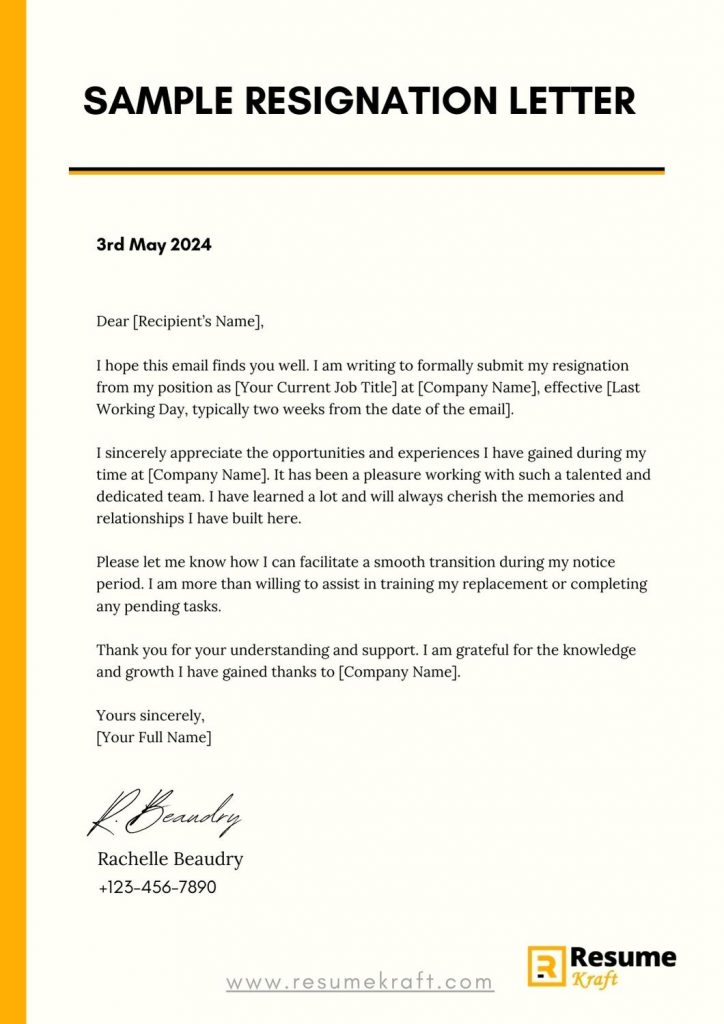
Download sample resignation letter in PDF format
Dear [Recipient’s Name],
I hope this email finds you well. I am writing to formally submit my resignation from my position as [Your Current Job Title] at [Company Name], effective [Last Working Day, typically two weeks from the date of the email].
I sincerely appreciate the opportunities and experiences I have gained during my time at [Company Name]. It has been a pleasure working with such a talented and dedicated team. I have learned a lot and will always cherish the memories and relationships I have built here.
Please let me know how I can facilitate a smooth transition during my notice period. I am more than willing to assist in training my replacement or completing any pending tasks.
Thank you for your understanding and support. I am grateful for the knowledge and growth I have gained thanks to [Company Name].
Yours sincerely,
[Your Full Name]
Tips:
- Keep the email concise and professional.
- Mention your last working day.
- Offer assistance during the notice period.
Short Resignation Letter
Sometimes, a short and to-the-point resignation letter is all you need. Here’s a sample of a short resignation letter:
Sample Resignation Letters:
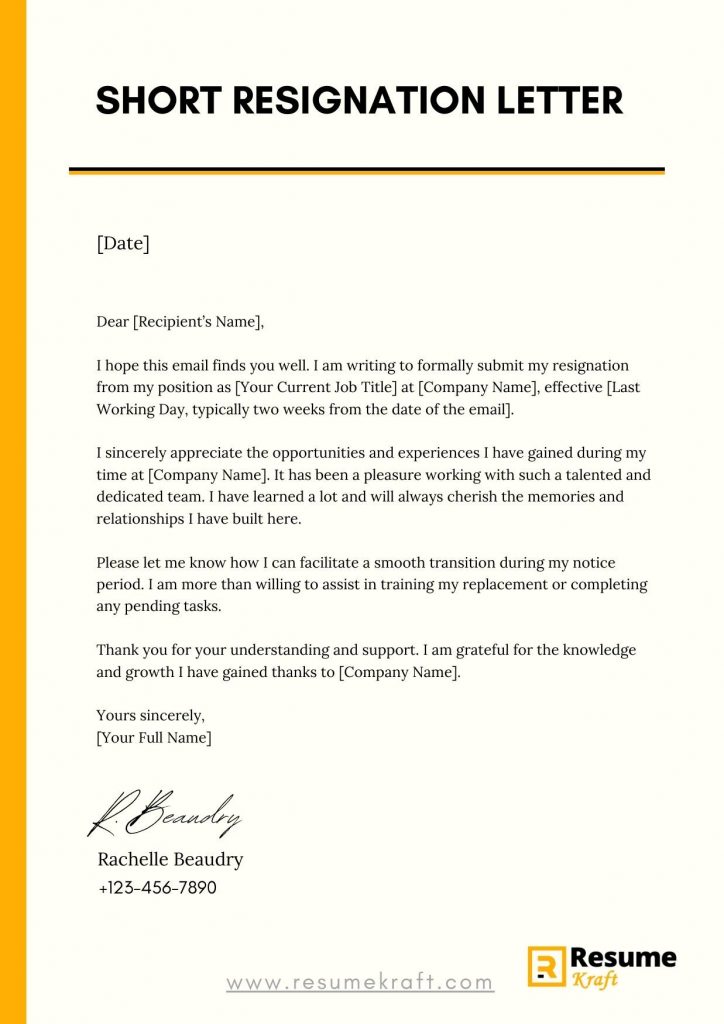
[Date]
[Recipient’s Name]
[Recipient’s Job Title]
[Company Name]
[Company Address]
Dear [Recipient’s Name],
I am writing to formally tender my resignation from my position as [Your Current Job Title] at [Company Name], effective [Last Working Day, typically two weeks from the date of the letter].
I would like to express my gratitude for the opportunities and support I have received during my time at [Company Name]. It has been a pleasure working with the team and contributing to the company’s success.
Please consider this letter as my formal notice of resignation. I will ensure a smooth transition by completing any pending tasks and assisting with the handover process.
Thank you for your understanding.
Best regards,
[Your Full Name]
[Your Contact Information]
Tips:
- Keep the letter concise and focused.
- Include your last working day.
- Express gratitude for your time at the company.
Constructive Dismissal Resignation Letter
In cases of constructive dismissal, where you believe your working conditions have become unbearable, it’s important to resign formally. Here’s a sample resignation letter for constructive dismissal:
Sample Resignation Letters:
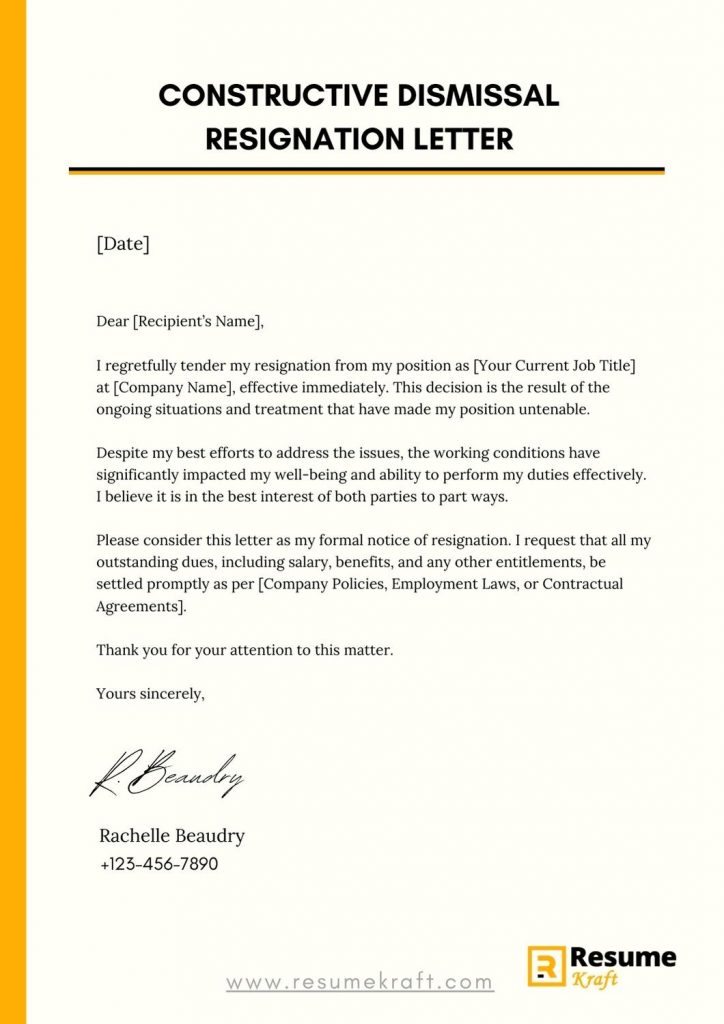
[Date]
[Recipient’s Name]
[Recipient’s Job Title]
[Company Name]
[Company Address]
Dear [Recipient’s Name],
I regretfully tender my resignation from my position as [Your Current Job Title] at [Company Name], effective immediately. This decision is the result of the ongoing situations and treatment that have made my position untenable.
Despite my best efforts to address the issues, the working conditions have significantly impacted my well-being and ability to perform my duties effectively. I believe it is in the best interest of both parties to part ways.
Please consider this letter as my formal notice of resignation. I request that all my outstanding dues, including salary, benefits, and any other entitlements, be settled promptly as per [Company Policies, Employment Laws, or Contractual Agreements].
Thank you for your attention to this matter.
Sincerely,
[Your Full Name]
[Your Contact Information]
Tips:
- Be clear about the reasons for your resignation.
- State the effective date of your resignation.
- Request a timely settlement of any outstanding dues.
Retirement Letter of Resignation
When retirement is on the horizon, a retirement letter of resignation allows you to formally inform your employer. Here’s a sample resignation letter for retirement:
Sample Resignation Letters:
![I am writing to inform you of my decision to retire from my position as [Your Current Job Title] at [Company Name], effective [Retirement Date].I want to express my heartfelt gratitude for the opportunities and support I have received throughout my tenure at [Company Name]. It has been an incredible journey, and I am honored to have contributed to the success and growth of the organization.I will do my best to ensure a smooth transition by completing any pending tasks and preparing detailed handover notes for my successor. If there is anything specific you would like me to focus on during this transition period, please let me know.Thank you once again for all the wonderful experiences.](https://resumekraft.com/wp-content/uploads/2023/07/Retirement-Letter-of-Resignation-724x1024.jpg)
[Date]
[Recipient’s Name]
[Recipient’s Job Title]
[Company Name]
[Company Address]
Dear [Recipient’s Name],
I am writing to inform you of my decision to retire from my position as [Your Current Job Title] at [Company Name], effective [Retirement Date].
I want to express my heartfelt gratitude for the opportunities and support I have received throughout my tenure at [Company Name]. It has been an incredible journey, and I am honored to have contributed to the success and growth of the organization.
I will do my best to ensure a smooth transition by completing any pending tasks and preparing detailed handover notes for my successor. If there is anything specific you would like me to focus on during this transition period, please let me know.
Thank you once again for all the wonderful experiences.
With warm regards and best wishes,
[Your Full Name]
[Your Contact Information]
Tips:
- Clearly state your intention to retire.
- Specify the retirement date.
- Offer assistance during the transition period.
One Week Notice Resignation Letter
In certain situations, you may need to provide a shorter notice period. Here’s a sample resignation letter with one week notice:
Sample Resignation Letters:

[Date]
[Recipient’s Name]
[Recipient’s Job Title]
[Company Name]
[Company Address]
Dear [Recipient’s Name],
I regret to inform you that I am resigning from my position as [Your Current Job Title] at [Company Name], effective [Last Working Day, typically one week from the date of the letter].
I apologize for the insufficient notice period, but due to unforeseen circumstances, I need to expedite my departure. I will make every effort to ensure a seamless transition by completing any critical tasks and providing necessary handover information.
I appreciate the opportunities and support provided by [Company Name] during my tenure. It has been a pleasure working with the team, and I will always have fond memories of my time here.
Thank you for your understanding.
Sincerely,
[Your Full Name]
[Your Contact Information]
Tips:
- Apologize for the short notice period.
- Provide a valid reason if possible.
- Offer assistance during the shorter transition period.
Two Week (or More) Notice Resignation Letter
A standard notice period for most resignations is two weeks. Here’s a sample resignation letter with a two-week notice:
Sample Resignation Letters:
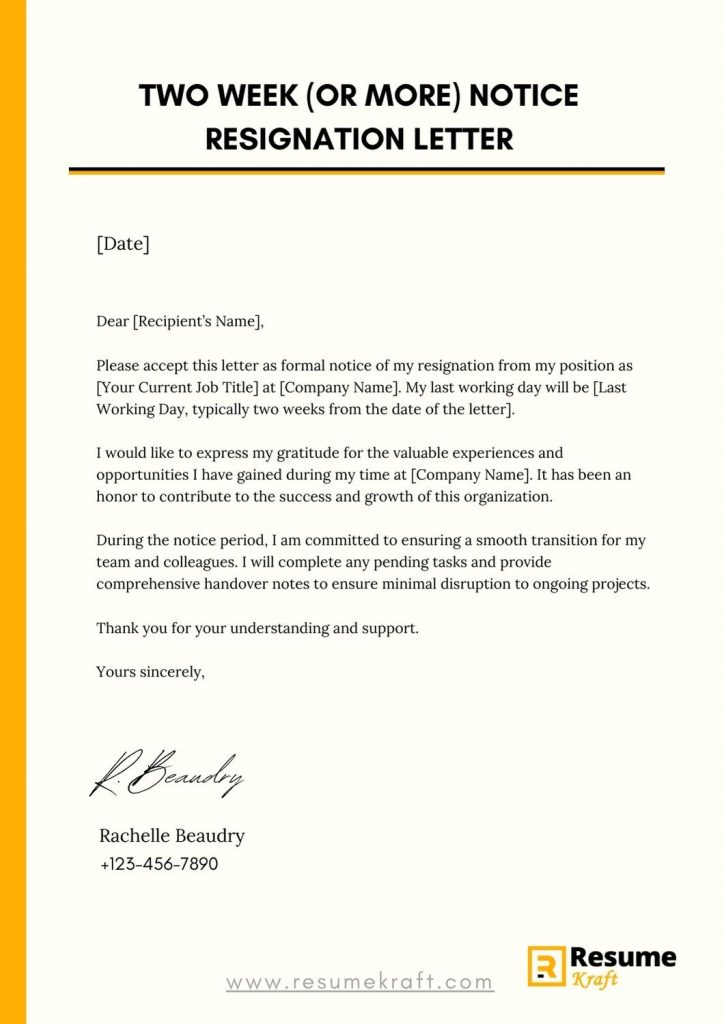
[Date]
[Recipient’s Name]
[Recipient’s Job Title]
[Company Name]
[Company Address]
Dear [Recipient’s Name],
Please accept this letter as formal notice of my resignation from my position as [Your Current Job Title] at [Company Name]. My last working day will be [Last Working Day, typically two weeks from the date of the letter].
I would like to express my gratitude for the valuable experiences and opportunities I have gained during my time at [Company Name]. It has been an honor to contribute to the success and growth of this organization.
During the notice period, I am committed to ensuring a smooth transition for my team and colleagues. I will complete any pending tasks and provide comprehensive handover notes to ensure minimal disruption to ongoing projects.
Thank you for your understanding and support.
Best regards,
[Your Full Name]
[Your Contact Information]
Tips:
- Provide a two-week notice period.
- Express gratitude for your experience.
- Offer assistance during the transition period.
Writing a resignation letter is an important task that requires careful thought and consideration. Use these sample resignation letters as a guide to create your own personalized letter. Remember to keep the tone professional and express gratitude for the opportunities received.
Read More:
- Resignation letter for higher studies
- Teacher resignation letter
- Medical assistant resignation letter
- Nurses resignation letter
- Guide to writing a forced resignation letter
- Board resignation letter
- Acceptance of resignation letter sample
- Resignation letter after maternity leave
- Resignation letter toxic work environment
- Voluntary resignation letter
- Physician resignation letter
- One week resignation letter
- Pastor resignation letter
- Resignation letter due to unfair treatment
- Resignation letter for medical reasons
- Church membership resignation letter
- Coaching resignation letter
- Internship resignation letter
- Law enforcement resignation letter
- Relocation resignation letter
- Resignation letter unhappy with management
- Resignation letter with reason of leaving
- Angry resignation letter
- Daycare resignation letter
- Doctor resignation letter
- Resignation letter due to illness
- Attorney resignation letter
- Restaurant resignation letter
- Staff nurse resignation letter sample
- Pharmacist resignation letter
- What is effective date in resignation letter
- Paraprofessional resignation letter
- Resignation letter due to bullying
- Resignation letter for moving
- Resignation letter for pregnancy
- Social worker resignation letter
- Teacher resignation letter to principal
- Volunteer resignation letter
- 1 month notice resignation letter
- Resignation acceptance letter with immediate effect
- How to write a resignation letter asking for severance with sample
- Resignation letter during probation period
- Resignation letter for immigration
- Resignation letter from club treasurer position
- Resignation letter when moving out of state
- 3 months notice period for resignation letter
- How to write an academic resignation letter with samples
- Church member resignation letter
- City council resignation letter
- Flight attendant resignation letter
- Resignation due to hostile work environment
- Letter of resignation moving out of state
- McDonald’s resignation letter
- Principal letter of resignation
- PTA resignation letter
- Resignation letter bad management
- Resignation letter changing career
- Resignation letter due to favoritism
- Resignation letter due to harassment
- Resignation letter family reasons
- Resignation letter medical assistant
- Resignation letter bad boss
- Letter of resignation nurse practitioner
- Police resignation letter
- Resignation letter with sadness
- Simple resignation letter for receptionist
- Resignation letter for higher studies
- Resignation letter for hotel industry
- Resignation letter for sales executive
- Chef resignation letter
- Internship resignation letter
- Resignation letter for assistant professor
- Housekeeping resignation letter
- Resignation letter due to low salary
- Resignation letter for accountant
- Resignation letter for bank employee
- Resignation letter for low salary
- Resignation letter due to study reasons
- Resignation letter for lab technician
- Resignation letter format for marriage reason
- NHS resignation letter
- Director resignation letter format
- Resignation letter tagalog
- Security guard resignation letter
- Resignation letter for production operator
- Resignation letter for driver
- Personal reason short resignation letter
- 15 days notice resignation letter
- Resignation letter to work abroad
- Resignation letter for card bank member
- Resignation letter service crew
- Security resignation letter
- Resignation letter for personal reasons with one-month notice
- Application for 3 days leave
- Leave application
- Irrevocable resignation letter samples for 2023
- Resignation letter for service crew
- Pastoral resignation letter
- Resignation letter
- Faculty resignation letter
Frequently Asked Questions about Resignation Letters
Writing a resignation letter may raise some questions or uncertainties. To help address those concerns, here are some frequently asked questions about resignation letters along with their answers:
Writing a resignation letter is an essential professional courtesy. It serves as a formal notice to your employer that you will be leaving the company and provides them with adequate time to plan for a smooth transition. It also helps maintain a positive relationship with your current employer, which may be beneficial for future references or networking opportunities.
The notice period typically depends on your employment contract or company policy. It is common to provide a notice period of two weeks. However, in some cases, a longer notice period may be expected, especially for higher-level positions or specialized roles. Review your employment contract or consult with HR to determine the appropriate notice period required by your company.
It is best to hand in your resignation letter in person to your immediate supervisor or the appropriate person designated by your company’s policies. Request a meeting to discuss your resignation and present the letter during the meeting. Be prepared to answer any questions and discuss any necessary details regarding the transition period.
Conclusion
Writing a professional resignation letter is an important step in the process of leaving a job. By following the guidelines and examples provided in this article, you can create a resignation letter that showcases your professionalism, gratitude, and commitment to a smooth transition.
Remember to use a business letter format, clearly state your last date of employment, offer assistance during the transition, express gratitude to your employer, and provide your contact information for future communication. Proofread your letter carefully to ensure accuracy and professionalism.
The examples provided in this article offer templates that you can adapt to your specific situation, whether you’re resigning via email, giving a short notice, addressing a constructive dismissal, retiring, or providing a longer notice period.
Writing a well-crafted resignation letter demonstrates your respect for your employer and colleagues and leaves a positive impression. It also helps maintain a good professional relationship and can be beneficial for future references or networking opportunities.
We encourage you to use the provided templates and tips as a starting point to craft your own resignation letter, tailoring it to your unique circumstances. Remember, each resignation letter should be personalized to reflect your own experiences and express your genuine gratitude for the opportunities you’ve had.
As you embark on this new chapter of your professional journey, we wish you all the best in your future endeavors. Good luck with writing your resignation letter, and may it pave the way for a successful transition.

Build your resume in 5 minutes
Our resume builder is easy to use and will help you create a resume that is ATS-friendly and will stand out from the crowd.
Recommended Reading:
![Resignation Letter: 10+ Downloadable Sample Templates [Latest 2025]](https://resumekraft.com/wp-content/uploads/2022/08/resume-kraft-logo-6.png)
